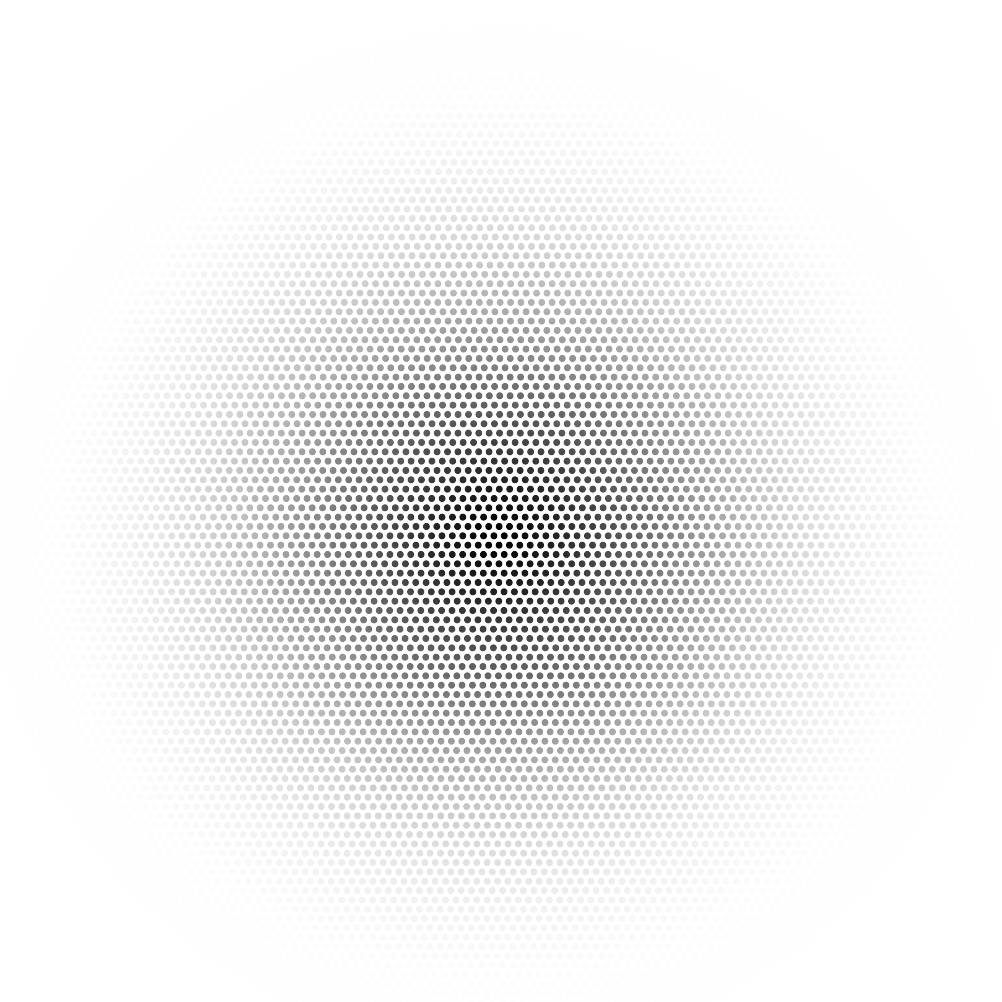
Rampion Offshore Wind Farm, UK (image taken by Nicholas Roche)
Offshore wind turbines are an important cornerstone of the renewable energy sector. They enable a capacity utilization of up to four thousand full load hours. As with any other structure, however, they have to undergo regular maintenance and inspections. Up to now, these inspections are quite expensive, time-consuming, and risky, as they are still partly carried out on site by divers.
The use of remotely operated underwater vehicles (ROV) has been increasing for years, but is mostly limited to RGB-based video techniques or the use of sonars. Therefore, a comprehensive quantification of the damage is limited.
The new sensor carrier MISO-Inspector (multi input single output) sensor carrier is intended to contribute to this improvement. This is a multivariate inspection and analysis system which, in addition to existing sensor technologies, will test and offer the utilization of new types of sensor technology for underwater use. Mounted on a ROV (Remotely Operated Vehicle), the MISO-inspector is able to perform inspection tasks above and under water.
The included sensors comprise, among others, a snapshot hyperspectral camera. It enables the non-contact detection, differentiation and analysis of materials. Since it is challenging for engineers to distinguish rust or other damage from marine growth, contamination, etc. with underwater RGB-images alone, the hyperspectral camera can open completely new possibilities for the identification of damage.
Steel tube spectroscopy
Different materials (steel pipe without corrosion, steel pipe with corrosion, aluminum coating and paint coating) were used as test objects, which are characteristic for offshore structures. For the measurements, the Hyperspectral VNIR Camera FireflEYE 185 was encased in a modified waterproof housing, allowing depth of up to 60m. For underwater illumination, different light sources, such as LED and halogen lamps, were tested. The investigations under water were carried out in a test basin at a depth of 1 meter.
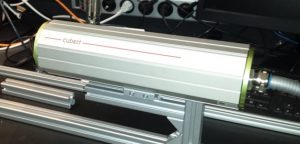
FireflEYE 185 in customized waterproof housing, tested for depth of up to 60m

Steel tubes coated with protective paint (left), corroded steel (middle), steel without corrosion (right)
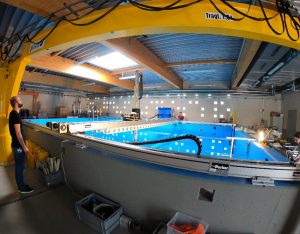
Experimental setup in the test basin of Institute of Applied Systems Technology (AST) in Illmenau
In the following first measurements have been carried out, to investigate the discriminability of relevant materials, the influence of different light sources and the practicabiltiy of reflectance calibration in an underwater environment. The measurements were performed using halogen and LED illumination.
To determine the reflectance values under water, a white target was carried along with the sensor. A differentiation between the materials was found to be possible with both LED and halogen light sources.
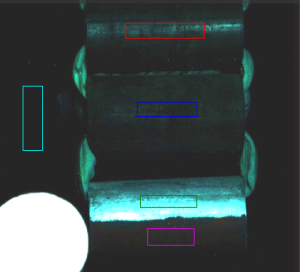

Pan image (true color) of the steel pipes with corresponding spectral signatures, as taken in Cubert Cuvis software. The white circle on the bottom left is the white target that was used for reflectance calibration. The uncorrected spectral signatures of the test objects (steel without corrosion, steel with corrosion, aluminum and color coating) and the background are based on LED illumination.
The spectral signatures represent all averaged pixels inside the particular colored rectangles, drawn in the image left. The error bars show the standard deviation for each wavelength. The spectrum beyond 780 nm is not included in the comparison, since there is a strong absorption in the infrared spectral range in water, and the LED illumination used does not cover this spectral range.
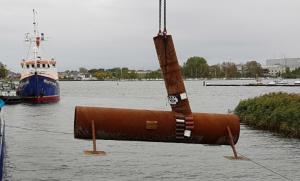
Steel pipe node with test objects, sunk into the harbor basin
After the successful testing in the test basin, the spectral camera was integrated to the MISO-inspector, which in turn was integrated into an ROV. To face the harsher conditions in seawater and deeper water tthe hyperspectral camera was equipped with SubConn underwater cables and connected to the MISO-inspector system carrier. The next test took place in the port of Rostock, Northern Germany. This involved submerging a pipe node equipped with the test objects to be examined in the harbor basin.
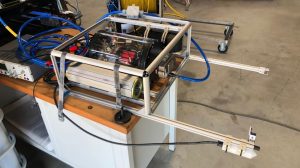
MISO Inspector carrying the hyperspectral camera, a multibeam SONAR and the central processing unit
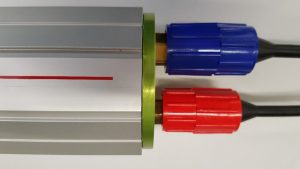
Modified connection setting of the FireflEYE 185 based on SubConn plugs.
The final examination of the MISO-Inspector was carried out under real conditions at an offshore structure. The pictures show the wind farm, the test facility and the watering of the ROV with the MISO-Inspector. The tests showed how organization-intensive and weather-dependent the inspection can be. Nevertheless, the measurements with the MISO-Inspector and with the HSK respectively were carried out successfully, so that the analysis of the measurements was possible in the next step.
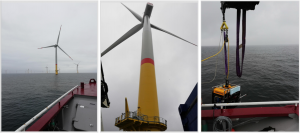
Offshore operation in the wind farm © Wölfel AG 2021. All rights reserved.

Aluminum structure in RGB (left), panchromatic (middle), and HSI false color (right)
The underwater images show the offshore structure at a depth of 30 meters with different materials, such as paint coating, organic materials, and not clearly identifiable bright areas, either aluminum areas or organic origin. The aluminum areas represent an indicator of possible damage of the offshore structure. Therefore, the identification of these surfaces is crucial, however it is not possible using only RGB or black and white images. Hyperspectral imaging allows identification of those materials. By analyzing the spectral information, the objects could be confirmed being aluminum. In combination with further information about the offshore structure, this evaluation enables an improved assessment of its current condition and a more reliable foundation for decisions on further action.
What’s next?
Since the MISO Inspector also passed the seawater testing successfully the system is nowadays in further evaluation in its final destination, i.e. offshore windparks in both the North Sea and the Baltic Sea. The project showed how hyperspectral snapshot imaging can contribute to new applications, such as damage indication detection of metal structures under water. We are looking forward to seeing more underwater applications in the future, as this is an exciting new world for spectral imaging!
Project information
The project was funded by BMWK (Federal Ministry for Economic Affairs and Climate Action) under FKZ: 03SX449A. The following partners have joint the project:
- Wölfel Engineering GmbH + Co. KG
- Bundesanstalt für Materialforschung und -prüfung
- BALTIC Taucherei- und Bergungsbetrieb Rostock GmbH
- Cubert GmbH
- E.ON Climate & Renewables GmbH
- Fraunhofer IOSB
- Schweißtechnische Lehr- und Versuchsanstalt Mecklenburg-Vorpommern GmbH
For more information please contact Dr. Viktoriya Tsyganskaya, who was leading the project for Cubert.

